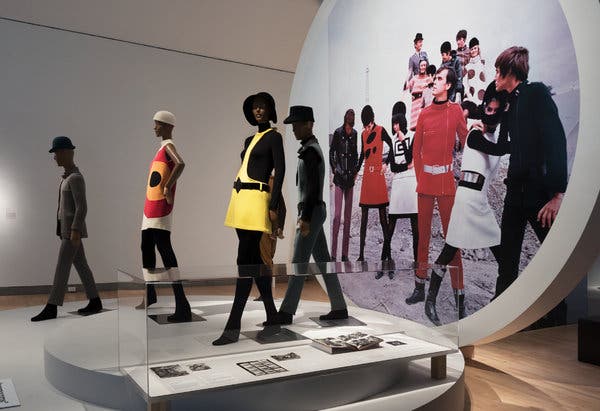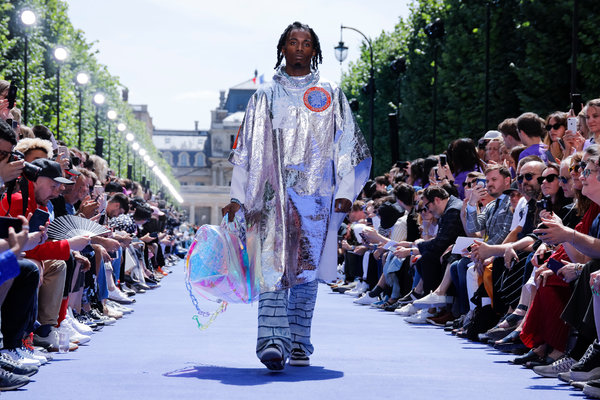Our museums, movies and magazines have been on a yearslong binge of ’60s nostalgia, pegged to a rolling sequence of 50th anniversaries: the Rev. Dr. Martin Luther King Jr. and Neil Armstrong, Woodstock and the Manson murders. It seems Americans can’t get enough of the era, and the optimism that percolated amid great social upheaval. But well beyond our borders, before the 1973 oil crisis tanked the global economy, other countries were partying and protesting just as hard, and a youth culture of sex, drugs and rock ’n’ roll spanned the globe. This country had no monopoly on grooviness.
“Pierre Cardin: Future Fashion,” now on view at the Brooklyn Museum, offers a swinging reintroduction to Parisian style in the 1960s and 1970s, when the New Look gave way to thigh-high boots and dresses of heat-molded synthetics. The Concorde was flying, Françoise Hardy and Joe Dassin were singing and women (and men) cruised the Left Bank in Mr. Cardin’s stretchy knits and swooping miniskirts.
With 85 ensembles, the earliest dating from 1953 and the most recent from this decade, “Future Fashion” is not, strictly speaking, another ’60s show. But its core are the space-age outfits that Mr. Cardin designed in a young, newly prosperous Paris, seen here on mannequins as well as in photographs and films of Jeanne Moreau, Mia Farrow and the cast of “Star Trek.” Some are chic, many are risible; all of it has an exuberant view of the future that marks it as decidedly from the past.
Mr. Cardin, one of the most commercially successful of all French designers (and still working at 97), was never a great artist in the manner of Christian Dior, Cristóbal Balenciaga and Yves Saint Laurent. Born Pietro Cardin in 1922, he fled with his family from fascist Italy to Vichy, which would become the seat of France’s nominal government in 1940. After the liberation of France, he moved to Paris and apprenticed with the couturier Jeanne Paquin. Later he worked in the studios of Elsa Schiaparelli and Dior, went into costuming and presented his first couture collection in 1953. He won acclaim for his “bubble dresses” (disappointingly absent from this show), cinched at the waist and hem. Here are a beige coatdress of beige bouclé wool, plus a fitted day suit worn by Jackie Kennedy; both have thick roll collars that would become a Cardin signature.
In 1959, Mr. Cardin did something shocking: He mounted a ready-to-wear presentation, at Printemps department store in Paris. It was one of the first by a named designer, and for his effrontery he was kicked out of the French haute couture guild. (He was later readmitted.) But Mr. Cardin was ahead of his time in anticipating the allure of high fashion for the middle classes, enjoying the 30-year postwar boom later christened the Trente Glorieuses.
He masterminded a business approach now gone general: glamorous couture as a loss-leader, ready-to-wear as the profit center and licensing deals to radiate your name worldwide. It made Mr. Cardin rich — he would go on to buy and to franchise the famed Parisian bistro Maxim’s — even as these licensing arrangements left the Cardin brand, stuck onto bottled water and tinned cassoulet, diffuse and cheapened.

CreditJonathan Dorado/Brooklyn Museum
Where he excelled was in bold, futuristic day wear, often with unorthodox cuts that reshaped or disguised the body. A pink leather jacket from 1980 has bulging shoulders like the pauldrons of medieval armor; the arms of a wool woman’s suit disguise the wearer’s body with oversized fabric circles. One mannequin sports a brown sweater and paneled skirt as well as a Plexiglas helmet, like a on-trend Apollo astronaut. Mr. Cardin took his space travel seriously: In 1969, he went to Houston and quizzed officials at NASA headquarters about how to stay stylish on the moon.
Like his colleagues André Courrèges and Mary Quant, Mr. Cardin proposed a sleek, forward-dawning fashion that sometimes dissolved gender distinctions — above all in his “Cosmocorps” collections of the mid-1960s, whose zipped sweaters and belted jumpsuits could be worn by men and women. Other outfits from the late ’60s are rather less unisex, like a “porthole” dress with cutout nipples. A man’s jumpsuit of teal wool felt features a leather thong worn over the trousers: one part Superman, two parts Tom of Finland.
Especially when compared to the day wear, most of Mr. Cardin’s evening gowns are tacky and uncreative. He is hung up on stretchy fabrics shaped by stiff hoops; one dress of black jersey incorporates six parallel rings, spaced out from the waist to the feet, that give it the look of a collapsible laundry hamper. None of these ensembles, presented together in a pin-lit gallery meant to evoke a sky full of stars, displays any of the exacting craftsmanship that Issey Miyake or Hussein Chalayan would bring to body-disguising gowns. And only a few, like a “light-up” dress with an LED tube sewn onto the chest, have the daffy futurism of the Cosmocorps.
CreditJonathan Dorado/Brooklyn Museum
The late ’60s and early ’70s in Paris were a time for dreaming, of new societies and even new planets. Those dreams, at least, have not gone out of fashion; even the background music in this show, by such contemporary French D.J.s as Air and Mirwais, conveys the enduring appeal for new artists of earlier Paris night life. Leather masks, neoprene harnesses, hooped shoulders, dresses you can see in the dark: All of them, even the most recent ones, bristle with the memory of a European economic miracle that has come and gone, but which endures all these years later in our visions of the future.
Remember the future? Most of the clothes in “Future Fashion” were made two decades before I was born, and before our ecocidal species had the full number on the uninhabitable earth that awaits us in the 21st century. In the catalog, Mr. Cardin is asked to imagine what we’ll all be wearing five decades from now, and with a laugh he says, “Women will wear Plexiglas cloche hats and tube clothing; men will wear elliptical pants and kinetic tunics.” A nice vision — yet, as this show affirms, also weirdly retro; that was what we were already wearing 50 years previously, not 50 years hence. I’ve been trying to imagine a more serious future fashion for 2069: cuffed, waterproofed trousers for wading through flooded megacities, maybe, or coverall onesies with holsters for ice packs.
Pierre Cardin: Future Fashion
Through Jan. 5 at the Brooklyn Museum, 200 Eastern Parkway, Brooklyn; 718-638-5000, brooklynmuseum.org.









